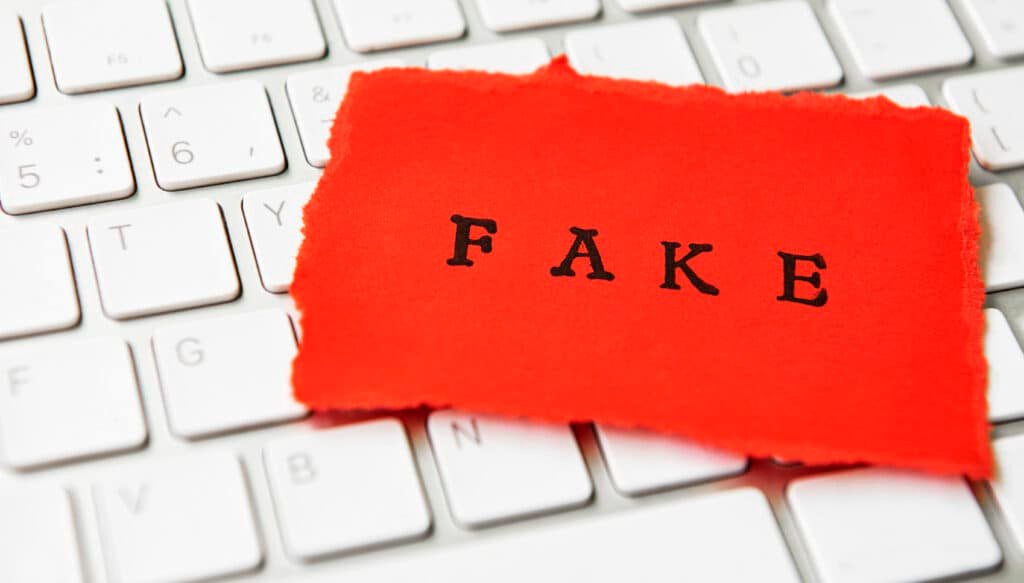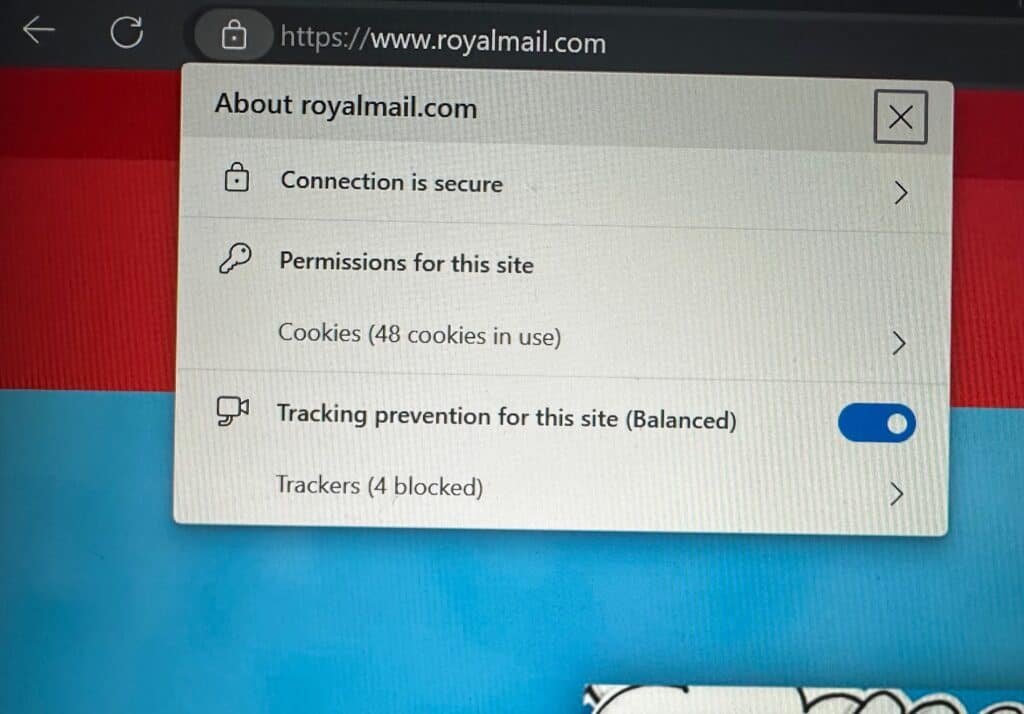Royal Mail email scams – How to spot and avoid in 2023

We may earn a small fee from the companies mentioned in this post.
Picture this: You receive a seemingly innocent email, claiming to be from Royal Mail, notifying you about a package awaiting delivery. Excited, you open the email, only to realise later that you’ve fallen victim to a scam. It’s a disheartening experience, isn’t it? In today’s digital world, Royal Mail email scams, are becoming increasingly common, and anyone can fall prey to them.
Wouldn’t it be great if you could learn how to spot and avoid these scams, protecting yourself and others from potential financial loss and emotional distress? That’s exactly what we’ll explore in this blog post.
By the end of this post, you’ll be equipped with the knowledge to identify common red flags in scam royal mail emails and fake Royal Mail websites, take proactive steps to protect yourself, and report scams to the appropriate authorities. Let’s dive in!
Key takeaways – Royal Mail scams
Recognise common red flags of Royal Mail email scams, including suspicious sender addresses, poor grammar and spelling, and urgent language.
Identify fake Royal Mail websites by examining insecure URLs (Websites), non-official logos and security certificates.
Protect yourself from potential scams by verifying email links, contacting Royal Mail directly, updating your security software, forwarding suspicious emails to 7726 or Action Fraud, and sharing scam details with others.
Recognising Royal Mail Email scams

Recognising the telltale signs is the initial step towards dodging a Royal Mail email scam. Scammers often employ a few common tactics to deceive their targets, such as using suspicious sender addresses, exhibiting poor grammar and spelling, and employing urgent language to provoke a quick response. By familiarising yourself with these red flags, you can prevent yourself from becoming their next victim.
Subsequent sections will explore these red flags in greater detail, offering practical advice and illustrations to assist you in identifying and evading Royal Mail email scams, including the notorious royal mail scam.
Suspicious sender addresses
One of the most obvious giveaways of a scam email is a suspicious sender address. Scammers often use:
Generic or impersonal greetings such as “Attention Royal Mail Customer”
Forged email addresses that are not connected to the official Royal Mail domain
Unknown sender names
These tactics are used to deceive their targets.
When encountering an email with a dubious sender address, proceed with caution. To verify the legitimacy of emails claiming to be from Royal Mail, you can contact Royal Mail Group Ltd directly. Additionally, updating your security software can help protect you from phishing scams and other potential threats.
Poor grammar and spelling
Poor grammar and spelling are often indicative of a fraudulent message, as scammers may not have the necessary time or resources to proofread their messages, especially when trying to imitate Royal Mail branded communications. Examples of poor grammar and spelling include:
Misspelled words
Incorrect punctuation
Incorrect verb tenses
Incorrect sentence structure
Identify poor grammar and spelling by thoroughly reading the message, hunting for misspelled words, and verifying punctuation accuracy. This can help you spot scam messages that request payment or personal information, allowing you to avoid falling victim to these scams.
Urgent language
Scammers frequently use urgent language in their emails to induce recipients to take prompt action, such as clicking a link or furnishing personal information. Examples of urgent language in Royal Mail emails include:
“Urgent Action Required”
“Immediate Response Needed”
“Time-Sensitive Information”
“Important Notice: Verify Your Account Now”
The intent behind the use of urgent language is to create a sense of urgency, compelling recipients to respond promptly, which often results in people becoming scam victims. Therefore, it is crucial to take precautionary measures and confirm the legitimacy of any email or Royal Mail branded website before supplying personal information or activating any links.
You may find our informative article on HMRC scam calls useful
Identifying fake Royal Mail websites

Having learned how to identify red flags in scam emails, it’s now necessary to learn how to discern fake Royal Mail websites. Scammers create counterfeit websites with the intent of acquiring your card details by directing you to a fake site that appears legitimate. These fake websites often impose additional fees to pay, with the aim of obtaining your card details and other sensitive information.
The following sections will dissect three key indicators of a counterfeit Royal Mail website: insecure URLs, non-official logos, and security certificates. By understanding these indicators, you can protect yourself from falling victim to delivery scams.
Insecure URLs
An insecure URL is a website address that does not commence with “https://“, or contain any misspellings of “Royal Mail”. Scammers often use such URLs to create a scam site that appears legitimate. To identify an insecure URL, look for URLs that do not commence with “https://“ or incorporate misspellings of “Royal Mail”, such as “Royal Male”.
Should you click on an unsecured URL, contact Royal Mail immediately to report the incident. By being mindful of insecure URLs and verifying the destination of links before clicking, you can protect yourself from potential scams.
Unofficial Royal Mail logos
Unofficial Royal Mail logos are another giveaway of a scam website. These are low-quality or altered versions of the Royal Mail logo that scammers use to deceive their targets. To distinguish between official and unofficial Royal Mail logos, inspect for indications of low-quality or modified versions, including pixelated images, inaccurate colours, or incorrect font sizes.
By adhering to official Royal Mail websites and carefully verifying the URL before entering any confidential data, you can avoid falling victim to scams that use unofficial Royal Mail logos and even those related to customs fees.
Absence of security certificates
Digital certificates issued by a third-party organisation to verify the authenticity of a website are known as a security certificates. Legitimate websites display these certificates to demonstrate their legitimacy and provide assurance to visitors that the website is secure and reliable.
The picture below depicts the Royal Mail website, by clicking on the padlock to the left of the URL (website address) will provide the certificate information. You should ensure the website you are viewing states ‘Connection is secure’ within the box and the website address is accurate.

However, scam websites, which can be referred to as fake web sites, often lack these trust seals and security certificates. To spot their absence, look for websites that do not display any security certificates, and be cautious when submitting any personal or financial information to such websites.
Protecting yourself from Royal Mail email scams
Armed with the knowledge to spot red flags and identify counterfeit websites, it’s time to take proactive steps to shield yourself from Royal Mail email scams. In this section, we’ll discuss three methods to safeguard yourself: verifying email links, contacting Royal Mail directly, and updating your security software.

Implementing these preventive measures keeps you a step ahead of scammers, safeguarding your personal and financial data.
Verifying email links
Verifying email links is a crucial step towards self-protection from scams. Before clicking on any link in an email, hover over the link to examine its destination. If you come across any suspicious links, it’s best to avoid clicking on them.
Email link verification helps safeguard against potential scams and malevolent links. By being vigilant and taking the time to verify email links, you can protect yourself from falling victim to phishing scams and other online threats.
Checkout our informative aritcle on how to spot a Phishing email
Contacting Royal Mail directly
Directly contacting Royal Mail is one of the most effective ways to verify the authenticity of email and SMS notifications purportedly from them. By reaching out to Royal Mail through their approved channels, you can confirm the legitimacy of the communication and avoid becoming a victim of scams.
To contact Royal Mail, you can make a telephone call to 03454 04 05 06, write to Citizens Advice consumer service, or fill out their online form. Taking this extra step to verify the origin of an email or SMS notification can save you from potential financial loss and emotional distress caused by a royal mail scam text.
Updating security software
Keeping your computer or smart device security software updated is vital as it aids in protection from potential threats. Security software is consistently being improved to defend against the most recent threats, thus it is imperative to ensure your security software is up-to-date.
Most security software programmes possess an automatic update feature that will keep your software current. By keeping your security software updated and practicing safe browsing habits, you can effectively protect yourself from Royal Mail email scams and other online threats.
Checkout our informative article on improving your online security
How to report Royal Mail email scams

If you encounter a Royal Mail email scam or a text message indicating an outstanding delivery payment, it’s vital to report it. Reporting scams not only helps you, but it also aids in preventing others from falling victim to the same scams.
This section will cover three methods of reporting Royal Mail email scams: forwarding dubious emails, reporting to Action Fraud, and sharing scam details with others. By reporting scams, you can contribute to raising awareness and help put an end to these malicious activities.
Forwarding suspicious emails

Reporting scams can be done effectively by forwarding suspicious emails to Royal Mail’s reporting service. To forward a suspicious email, simply send it to reportascam@royalmail.com. By forwarding these emails, you can help Royal Mail identify and combat these scams, ultimately protecting others from falling victim to similar schemes.
Additionally, if you receive a spam text message, you can forward the text to 7726, a free service that helps report and combat spam text messages.
Reporting to Action Fraud
The UK’s national centre for reporting fraud and cybercrime is Action Fraud. If you suspect you’ve encountered a Royal Mail email scam, you can report it to Action Fraud by utilizing their online fraud reporting tool or calling them on 0300 123 2040.
When reporting to Action Fraud, provide as much information as available, including:
The date and time of the incident
The type of fraud
The amount of money lost
Any other pertinent details
Doing so can help them investigate and combat these scams more effectively.
Sharing scam details with others
Another effective method to raise awareness and prevent others from becoming victims of similar schemes is to share scam details with friends, family, and colleagues. By posting about the scam on social media platforms, sending emails, or utilizing messaging applications, you can spread the word about scams and help others stay vigilant.
Remember, knowledge is power – the more people are aware of these scams and how to spot them, the less successful scammers will be in deceiving their targets.
Summary
In conclusion, Royal Mail email scams are an unfortunate reality in today’s digital world. However, by arming yourself with knowledge and taking proactive steps, you can effectively spot and avoid these scams. Remember to be cautious of suspicious sender addresses, poor grammar and spelling, and urgent language in emails.
Additionally, always verify email links, contact Royal Mail directly, and keep your security software updated to protect against potential threats.
Stay vigilant, report scams when you encounter them, and share your knowledge with others. Together, we can put an end to these malicious activities and ensure a safer online experience for everyone.
You may find our informative article on ‘Royal Mail Fee to Pay Scam’ useful
Frequently Asked Questions
How do I contact the Royal Mail?
To contact Royal Mail, call them on 03457 740740 or fill in the complaint form available on their website.
How do I report an email address?
To report an email address, forward suspicious emails to report@phishing.gov.uk or to the abuse@ or postmaster@ address associated with the domain where the issue is occurring. Additionally, you can report the email address through apps such as Gmail by selecting “Report Junk” from the dropdown menu.
How do I know if an email from BT is genuine?
If the sender email address doesn’t have an association with bt.com, or if the ‘T’ in BT is used in lower case in the body of the message, it is likely to be a phishing scam. Additionally, watch out for spelling errors and avoid emails asking for sensitive information. Verify that your BT email address appears in the text of the email to confirm its authenticity.
Are there scam emails about parcel delivery?
Yes, there are scam emails about parcel delivery. Such scams often include attempts to get personal information or bank details by pretending to be from a delivery company, as well as providing false tracking information for items bought online that never arrive.
What are the telltale signs of a Royal Mail email scam?
Suspicious sender addresses, poor grammar and spelling, and urgent language in emails are telltale signs of a Royal Mail email scam.
Useful external references
- Royal Mail Official Website – www.royalmail.com
- Royal Mail’s official site often provides alerts and guidance on current scams, including those involving fraudulent fee-to-pay messages.
- Action Fraud – www.actionfraud.police.uk
- Action Fraud is the UK’s national reporting center for fraud and cybercrime. They provide information on various scams, including those related to Royal Mail.
- Citizens Advice – www.citizensadvice.org.uk
- Citizens Advice provides free, confidential information and advice on scams. They may have information on the Royal Mail fee to pay scam and how to report it.
With over three decades of experience in the heart of London’s financial sector, I have dedicated my career to the pursuit of robust cybersecurity practices and IT leadership. As a Certified Information Systems Security Professional (CISSP), Certified Information Security Manager (CISM), Certified Chief Information Security Officer (C|CISO), Certified Ethical Hacker (CEH), and Computer Hacking Forensic Investigator (CHFI), I bring a wealth of knowledge and expertise to the table.
My journey in the field of cybersecurity has not only been about personal growth but also about sharing my insights with others. As an international speaker, I have had the privilege of addressing audiences worldwide, discussing the importance of cybersecurity in today’s digital age. My passion for knowledge sharing extends to my work as an author and blogger, where I delve into the complexities of cybersecurity, offering practical advice and thought leadership.
In my role as a CISO and Head of IT, I have overseen the development and implementation of comprehensive information security and IT strategies. My focus has always been on creating resilient systems capable of withstanding the evolving landscape of cyber threats.
My Master’s degree in Cybersecurity has provided a solid academic foundation, which, when combined with my practical experience, allows me to approach cybersecurity from a holistic perspective.
I am always open to connecting with other professionals in the field, sharing knowledge, and exploring new opportunities. Let’s secure the digital world together.

